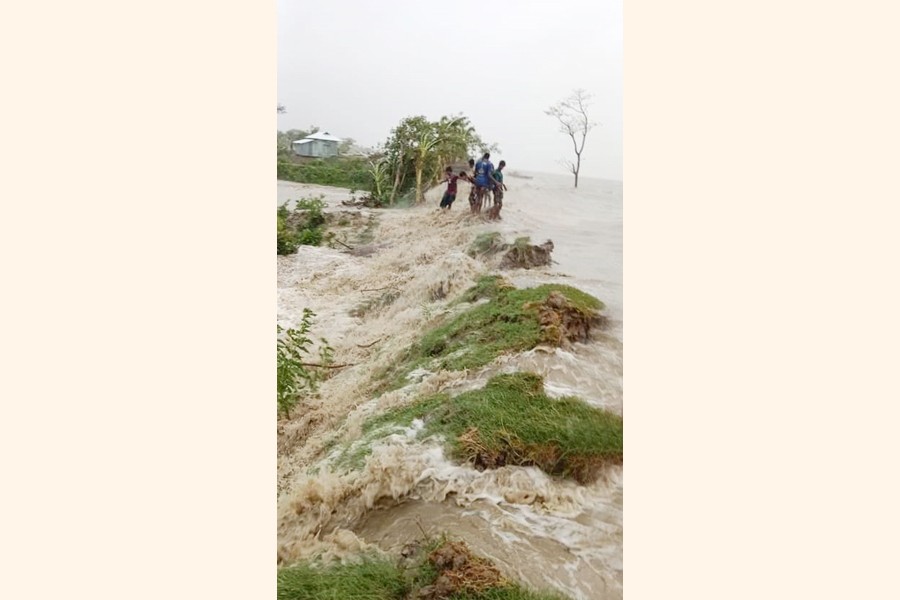
Apathy towards sufferings of Remal victims
Nilratan Halder | Friday, 31 May 2024

There seems to be a widespread indifference to the follow-up of Remal's devastation. The impression is that the intensity of the cyclone was somehow less than anticipated and once people came to know about it, they could mind businesses other than the trial and travails of the cyclone victims. How such a general impression got currency is not far to seek.
Primarily the media must take responsibility for not doing enough homework and then the local administration failing to show the urgency and seriousness of taking up the task of assessing the damages and highlighting the sufferings of people in the battered coastal regions. It is also a fact that the overall general mentality of the people has undergone a change for the worse after the pandemic. There has been a u-turn in the fellow-feeling and selfless devotion to charity for the distressed humanity. It is the middle class which came forward in the past whenever natural calamity struck anywhere in the country. Now with their back to the wall in this hard time of soaring inflation, people of this class are distraught. In fact, people in general have become tight-fisted.
So far as the local administration in the Remal-hit areas are concerned, to keep up with the past good work of taking people to cyclone shelters before the deadly phenomena's landfalls, they in collaboration with some voluntary organisations, have once again given an excellent account of themselves. But unfortunately post-cyclone engagement by various agencies has not quite evidently matched the pre-cyclone landfall initiatives.
The role of media in this regard has been perfunctory at best and biased at the worst. The sense of urgency of detailed reporting punctuated by human sufferings, heroism, if any, depicting a comprehensive picture is missing. With rare exceptions in the print media, the run of the mill ran stories rather casually. Where the coverage faltered most is in the preference for projection of urban miseries as a fallout of Remal in tandem with the devastation coastal people have witnessed. As if the coastal calamity is comparable with water logging and disruption of metro rail's service!
This is exactly why the nation could easily shift from this calamitous event to other non-serious distractions. People feel more or less unconcerned about the enormous suffering of the Remal victims. How are the displaced and homeless people managing their foods and drinking water? Where are they living with their families are no one's concern. There is virtually no news of immediate relief operation in the affected areas. Mindlessness unconcern is making the nation extremely selfish and this tendency is growing as evidenced by recent responses to the miseries of people during natural calamities in different parts of the country.
True, Remal weakened considerably at the time of its landfall, thanks to the Sunderbans that once again received the full force of the cyclone only to lessen its impact by the time it crossed the coastal areas. But what misses from the assumption that the 111 km/h wind speed did not pack a deadly force to unleash are the rising sea waves measuring as high as 10-12 feet which accompanied the wind. The consequences were disastrous for the frail and vulnerable embankments built to protect villages in low-lying areas in several districts of Khulna and Barishal divisions.
Reports are still patchy and the most comprehensive one carried in a contemporary comes up with an incomplete assessment of total losses. The death toll rose to 26 and in the 34 hours of battering, 3.7 million people had to endure the cyclone's fury. Only the fisheries sector's damage could be assessed at Tk 8.58 billion. Although the number of blown away or flattened houses was put at 0.15 million, no figure of crop losses could be available. Houses and vegetables that have gone under onrushing water overflowing or breaching embankments will sustain further losses. How will people of those inundated villages survive if the accumulated waters do not recede and give rise to a three-decade long manmade problem like that of Bhabadah covering villages of three upazilas in Khulna and two in Jashore?
This leads to the failure of the Bangladesh Water Development Board (BWDB) in building embankments strong enough to withstand the force of onrushing waters and also repairing those timely not only in the coastal regions in the south but also in the haor areas. The excuse that the BWDB has inadequate manpower is unacceptable. Losses of life and property to cyclones and super cyclones each time they strike are colossal. Even the material losses in terms of economy ought to be a compelling reason for expenditure of enough money on such embankments.
In this matter, the media have always played a positive role by bringing the dismal state of dams and embankments in the coastal and haor areas to the authorities' notice. It seems at times that the government agency could not care less when there is, in fact, an urgent need for addressing the vulnerable segments of embankments. Now that the prime minister herself has instructed for repair of the damaged embankments before the onset of monsoons, it can be hoped things will fall in places.
nilratanhalder2000@yahoo.com